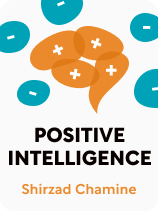

This article is an excerpt from the Shortform book guide to "Positive Intelligence" by Shirzad Chamine. Shortform has the world's best summaries and analyses of books you should be reading.
Like this article? Sign up for a free trial here.
Want to learn how to make sound judgments? What are the best skills to learn?
In a world filled with countless choices and constant distractions, the ability to make sound judgments is important if you want to find fulfillment. Shirzad Chamine’s book Positive Intelligence offers techniques to overcome the sabotaging forces of your mind and start making more beneficial decisions.
Read on to learn how to make sound judgments with Chamine’s five skills.
How to Make Sound Judgments
In Positive Intelligence, Shirzad Chamine explains that all of your stress and unhappiness is the result of antagonists in your brain—harmful patterns of thinking he calls Saboteurs—that sabotage your thinking and the way you experience life. If you want to make sound judgments and avoid making decisions you’ll later regret, Chamine provides advice on how to connect with your higher self—your Sage—to counteract these antagonists and improve every facet of your life.
(Shortform note: Since the term “sage” refers to someone with sound judgment, it’s an appropriate name for the part of your brain that combats the Judge—which makes unsound judgments.)
The Sage is the part of you that can control and override your harmful patterns of thinking. It embodies the part of your brain that developed to help you thrive and not just survive. The Sage accepts who you are and what your life is like in the present and views every change in circumstances as a gift.
Below, we’ll describe five techniques of the Sage that will help you to practice making sound judgments and avoid giving in to harmful thought patterns.
#1: Practice Empathy
This first technique for making sound judgments allows your Sage to offer gratitude, acceptance, and kindness to you and others. It is most beneficial when you or another person is feeling pain or fatigue. Empathizing heals and rejuvenates you so you can carry on with the emotional work you’re doing. This skill combats the Judge’s insistence that you or others aren’t trying hard enough and that you need to be stricter and more punitive to see improvement. It also helps you see past other people’s Saboteurs and keep them from provoking your own.
(Shortform note: When you offer yourself and others empathy and compassion, you experience a physiological response that helps your body rest by lowering your stress response. This, in turn, helps you relax. Conversely, thinking critically about yourself or others increases your body’s stress response, causing an accelerated heart rate and sweating. While you might be tempted to be more empathetic as a way to lower your stress response, it’s important to avoid falling into the trap of toxic empathy, or the tendency to empathize with others so intensely that their needs and problems begin to take precedence over your own. This can lead you to feed the Pleaser Saboteur. Balancing empathy for others with empathy for yourself can help you avoid this trap.)
People are often reluctant to offer empathy because they fear it will encourage negative behavior. They worry that showing compassion after someone makes a mistake is like condoning that mistake. However, Chamine encourages using empathy to make sound judgments and asserts that empathy helps heal the damage done by mistakes that would otherwise stand in the way of learning and growth.
| Empathy Versus Sympathy People often confuse empathy with sympathy, which can lead to a misuse of both skills. Empathy refers to feeling and understanding another person’s emotions, while sympathy refers more to feeling bad for someone. Some experts suggest that sympathizing with someone who’s behaving badly can mean you’re condoning their behavior because the pity you feel for them can cause you to want to spare them from the negative consequences of their behavior. Empathy, on the other hand, provides emotional context to understand what someone’s feeling and what may be motivating their behavior. It’s possible—and even beneficial—to empathize with someone you strongly disagree with, and such empathy can open the door to communication that can help correct the other person’s negative behavior. |
In order to employ your Sage’s empathy, Chamine recommends you visualize the recipient of your empathy as a child. For yourself, he suggests keeping a photo of yourself from childhood in a place that’s easily accessible so you can look at it when you’re feeling judgmental of yourself. For others, he recommends imagining what they were like before the Saboteurs of adulthood began to affect them. This will automatically prompt you to treat that person with more understanding and compassion.
(Shortform note: Other ways to practice empathy for others include going out of your way to meet new people and open yourself up to new perspectives, working on a project with them that combines your shared interests, and reading about people who are different from you (research suggests that reading fiction improves empathy and emotional intelligence). To get better at offering empathy to yourself, engage in self-care and activities that are comforting to you, write a letter to yourself describing what you’re feeling without placing blame on anyone, or talk to yourself like you would talk to a friend who’s struggling.)
#2: Be More Curious
Being more curious is another way to encourage sound judgments. By exploring, you can tap into your natural curiosity to discover new ideas or solutions to problems. It’s most effective when you know you have a problem but you need to understand it better to solve it.
Many of us resist exploration because we’re focused on pushing ahead or on rebutting someone else’s argument. Therefore, we don’t think about how we can re-examine what we’re seeing at the moment. If you already think you know what comes next, or if you’re just trying to win an argument, you’ll focus only on the information that supports your thinking rather than understanding every angle of a situation or listening neutrally to the other person’s point of view, and therefore you won’t explore alternative insights.
| Applying Empathy to Exploration Other experts suggest that the exploration stage also requires you to use empathy as you’re taking in other perspectives. The authors of The Anatomy of Peace explain that to fully understand a conflict, you need to take on a cooperative mindset, which involves treating others with compassion and empathy and opening yourself up to change. They contrast this with a combative mindset, which is when you view others and differing perspectives as obstacles instead of as tools for collaboration. A combative mindset can lead you to view others as inferior, dismiss their opinions as unimportant, and mistreat them as people. This keeps you from exploring the real problem at hand. In Nonviolent Communication, Marshall Rosenberg explains that we’re rarely taught how to listen to others with empathy, so we tend to listen while preparing our own responses or figuring out how to “fix” the other person’s problems. As Chamine explains, we’re only listening to the information that supports our own ideas, causing us to miss important details and perspectives. While they’re well-meaning, non-empathetic responses to others’ problems cause us to view the other person more as a project than a person. These responses include consoling the other person, giving them unsolicited advice, questioning what they’re saying, correcting them, or trying to turn their experience into a learning experience. Instead of these tactics, Rosenberg recommends frequently paraphrasing the other person’s words to make sure you’re understanding correctly. |
#3: Get Innovative
This technique allows you to create new, unexpected ideas and solutions to a conflict or problem without judgments or biases holding you back. It’s about generating as many new ideas as possible without evaluating them at all. Innovation works best when you’re in a situation where the old method of doing things is no longer effective and you need a new tactic.
(Shortform note: In Getting Things Done, David Allen explains that, in addition to avoiding judgment, you should refrain from trying to organize your or your team’s ideas as they come up, letting them arise organically and only worrying about organizing them after the brainstorming phase is over. Organizing takes mental energy that would be better used on creativity. He also recommends writing your ideas down rather than trying to keep track of them in your head so you can free up mental energy and space for even more innovation.)
To use innovation to make more sound judgments and overcome your Saboteurs, Chamine recommends that you follow each new idea that you or someone else generates with a “Yes…and…” statement. After you or someone else expresses an idea, say “Yes, here’s what I love about this idea…” and then you share your next idea. This encourages you (and your team if applicable) to acknowledge and show appreciation for each idea before moving on to the next, and it blocks out the negative feedback that would accompany sentences starting with “No” or “But.”
| How to Brainstorm Effectively Judging ideas as they come can make us susceptible to cognitive biases such as the familiarity bias, which makes us view ideas more favorably if they’re similar to ideas we’re already familiar with. This closes us off to more innovative ideas that could greatly improve our current methods. One reason brainstorming in groups isn’t always productive is that doing so often results in convergent thinking, which is when people’s ideas influence each other so that, when one idea is put forth, other ideas that follow are likely to be similar to that first idea. Brainstorming by yourself results in more divergent thinking, which leads to a wider variety of ideas. Instead of a traditional, in-person brainstorming session, some experts recommend virtual brainstorming, in which members of a group brainstorm individually and then anonymously add their ideas to a shared collaboration tool like Google Docs. Once all the suggestions have been gathered, team members can comment (also anonymously) on each other’s ideas, and they can be refined from there. This method could be combined with Chamine’s “Yes… and…” technique so that each comment not only addresses the positive aspects of the idea in question but also suggests a new direction or a separate but related idea. |
#4: Learn to Navigate Effectively
The navigation technique helps you choose your next steps by making a sound judgment when there are many options available to you. You’ll use this technique to evaluate your different options and decide—based on your personal values or the values of your team—which option is best.
To navigate effectively, you have to be in touch with your personal values, which can be difficult when your Saboteurs try to add false values. To take advantage of this technique, Chamine recommends that you imagine yourself at the end of your life looking back on this moment and ask yourself what you’ll wish you had done. This helps you shed your temporary concerns or superficial values and think about what truly matters to you. This way you can see what decisions work best in the moment, which will help you avoid regret in the future.
| Finding Your Values In Awaken the Giant Within, Tony Robbins explains that understanding our values can be difficult because many of them developed without our conscious knowledge. Many came from social conditioning from parents, teachers, or peers, so a lot of your current values relate more to behaviors that you were rewarded for than principles that are personally important to you. This opens the door for your Saboteurs to influence your values by tying them to other people’s perceptions of you. Robbins explains that there are two types of values: ends, or values that relate to a desired future outcome, and means, or values that relate to methods of achieving a desired outcome. He emphasizes that you should be aware of the differences between these two and avoid focusing exclusively on means because you’ll risk losing sight of what you ultimately want to achieve. For example, if the end value you want to achieve is to be self-confident, you may decide to pursue this through the means of exercise, focusing on the value of physical health. However, if you become overly fixated on the belief that you need to change your physical appearance, you may actually damage your self-confidence. Chamine’s exercise of imagining your future self looking back on you in the present moment can help you align your ends values with your means values. |
#5: Learn the Skill of Execution
This technique allows you to take action without interference from the Saboteurs (i.e., your negative thought patterns). It’s the tactic you should use once you’ve clearly identified the path you should take. It allows you to do what’s right calmly and without emotional attachment to the outcome.
To use your execution skills to make sound judgments, Chamine recommends anticipating the ways your Saboteurs will try to interfere with your action in advance. Once you’ve thought through the different lies your Saboteurs might tell you to keep you from taking action, it will be easier to confront and dismantle those lies when they come up later.
(Shortform note: In The Oz Principle, Roger Connors, Tom Smith, and Craig Hickman explain that taking action and executing a plan requires commitment and accountability, and they offer some tips for how to stay on track with your plan. They recommend that you keep track of your results, which will also help you measure your progress as you go. They also recommend that you stay vigilant and don’t let momentary successes keep you from moving forward with your plan—staying aware of your inner cheerleader and not letting it take too much control (which is the inverse of Chamine’s advice to be aware of your Saboteurs). Additionally, they suggest that you get comfortable with the feeling of risk, as this will help you bounce back and learn from failures and mistakes.)

———End of Preview———
Like what you just read? Read the rest of the world's best book summary and analysis of Shirzad Chamine's "Positive Intelligence" at Shortform.
Here's what you'll find in our full Positive Intelligence summary:
- The ten ways your brain sabotages your happiness and success
- How to train your brain to overcome its sabotaging behaviors
- How to increase your level of positive intelligence with attentional exercises






